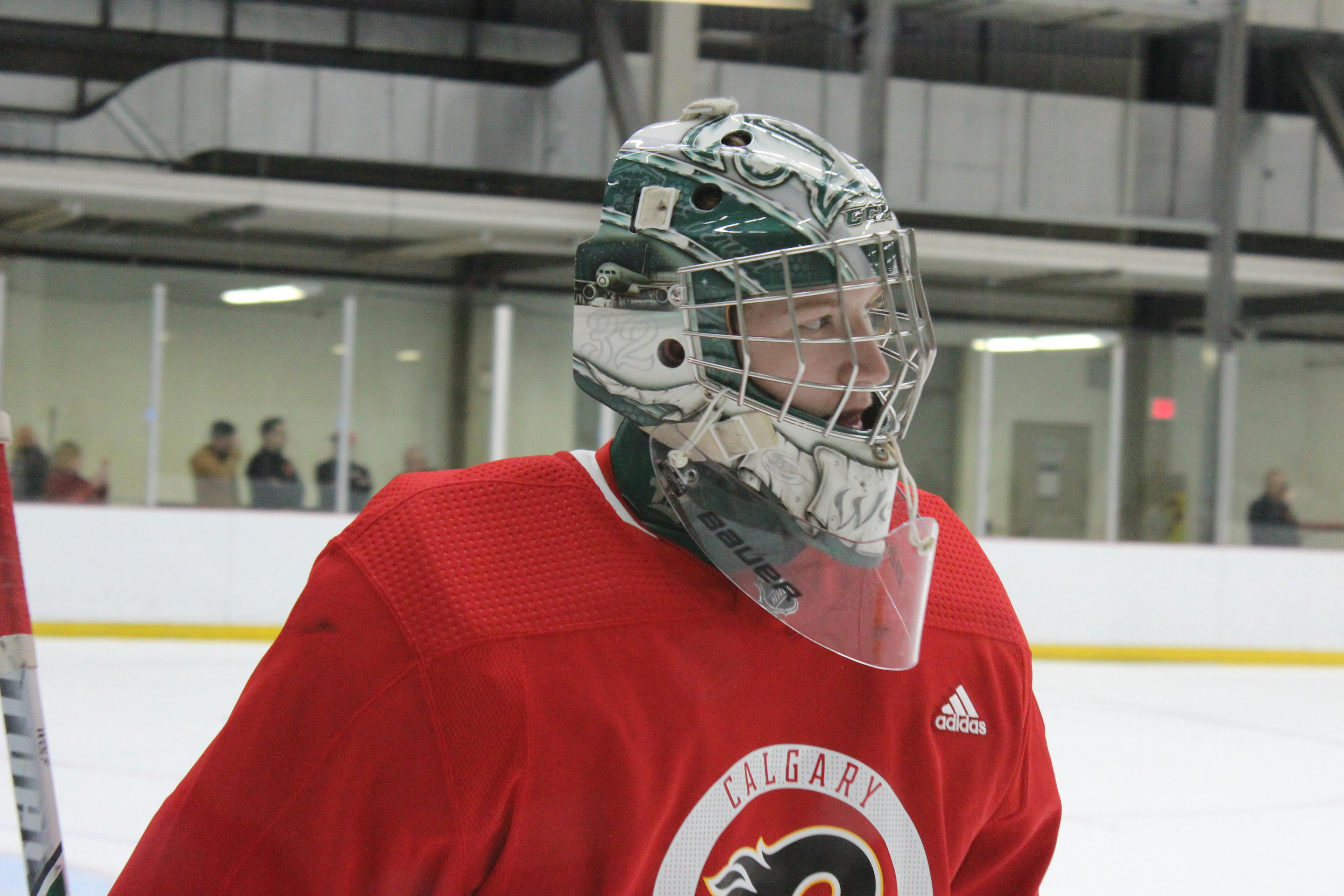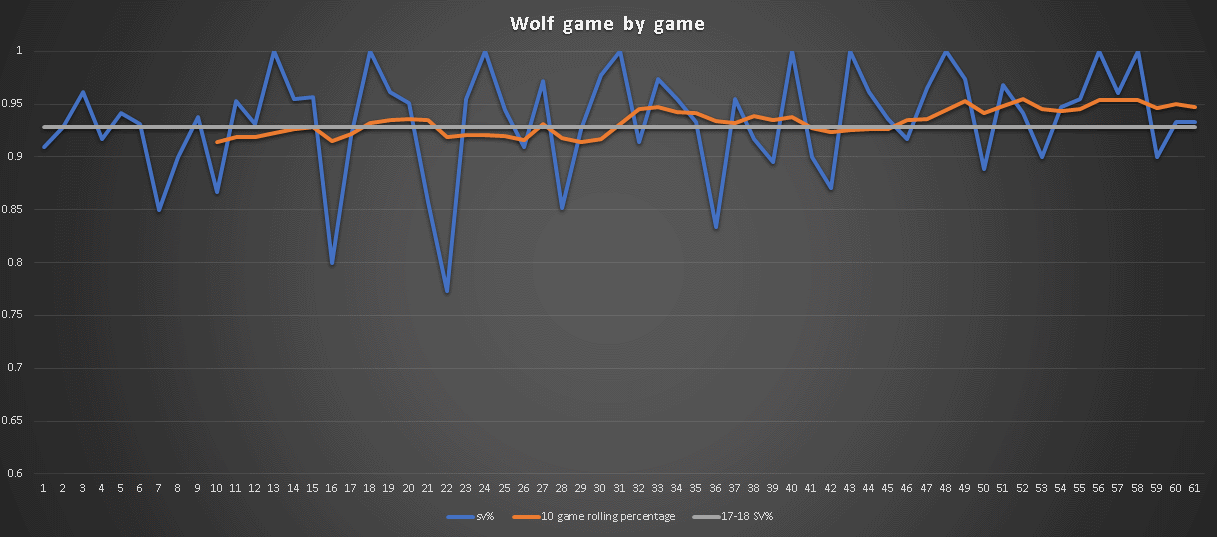Nation Sites
The Nation Network
FlamesNation has no direct affiliation to the Calgary Flames, Calgary Sports and Entertainment, NHL, or NHLPA
A closer look at Dustin Wolf

Aug 4, 2019, 12:00 EDTUpdated: Aug 4, 2019, 04:37 EDT
The Flames were going to draft a goalie at some point in the 2019 draft. With a glaring organizational need, it was only a matter of where.
They waited until the third last pick of the draft to select Dustin Wolf of the Everett Silvertips. Despite athleticism, an extremely high hockey IQ (just a high IQ in general- he was the WHL’s scholastic player of the year with a 100% average), a workhorse’s schedule, and downright nutty statistics, the WHL’s best goaltender nearly had to try his luck next year because he is 6’0 instead of an unspecified yet taller height.
So what do the Flames have in their potential seventh round steal?
The numbers
GP | Min | SV% | SV% rank among qualified goalies (/29) | SA | SA rank | GA | GA rank |
61 | 3615 | 0.936 | 1 | 1595 | 6 | 102 | 11 |
Qualified goalies = 1440 minutes played

Let’s rattle off some facts:
- Best qualified goaltender by SV%
- Most minutes played of all goaltenders
- Eight shutouts (and one shutout that he didn’t finish, which we’ll explain below)
- Nineteen additional games (so 27 in total) where his SV% was above .950
- Compare that to the 14 total games where his SV% was .900 or lower.
- This is as good a time as ever to mention that the WHL’s SV% was 0.899.
- Oh, and there were 31 games where he allowed one goal or fewer
- WHL games saw an average of 6.45 goals scored per game, so rounding down, a team could expect to score three goals per game. Wolf only allowed three or more goals 13 times all season.
- Did all of this before he could legally drink a beer in Calgary
- Compared to the best of the U18 goalies, he is 0.012 SV% points up on second place, 0.026 SV% up on third place, 0.027SV% up on fourth place, and 0.030SV% up on fifth.
- His SV% from last season (0.928 in 20 games played) would be third in the WHL this season.
- He is very, very good
I don’t have anything to criticize. Let’s find a thing to criticize, just to make this article slightly interesting.
Anyone who watches WHL hockey will tell you that Everett has been the virtuosi of playing suffocating defensive hockey. They’ve finished with the fewest goals allowed the past three seasons and haven’t finished outside of the top five since 2012-13. That’s right, Jarome Iginla was still a Flame the last time the Everett Silvertips were anything less than dominant at defence.
So, naturally, that gives Wolf an advantage most WHL goaltenders don’t have. Let’s look at the extremely WHL named Beck Warm, Tri City’s starting goaltender. Him and Wolf had scary identical usage, with Warm seeing 3614 minutes and Wolf seeing 3615, each in 61 games.
Warm saw 507 more shots than Wolf in the exact same time frame, which is nearly eight more per game (about 26 per game for Wolf and 34 for Warm). Wolf was well insulated by his defence, facing 20 or fewer shots in a fifth of the games he started. The average WHL game saw 63.8 shots per game, so let’s say 32 per side. Wolf only faced a league average or higher barrage 11 times this past season. He simply wasn’t seeing the shots other goaltenders were.
A fun example of Everett’s defensive dominance is a November game against the Kamloops Blazers. Wolf started the game, faced six whole shots by the end of 40 minutes, and was pulled for his backup in the third period because the team was up 6-0 at that point. The Silvertips felt it would be a waste of his time to see out the whole game (and add another shutout to his name) and played their backup for the remainder.
So there is a case to take Wolf’s impressive numbers with a grain of salt. Not to say that his impressive numbers are solely because of the defence in front of him – part of having low goals against numbers is thanks in part to your goaltenders- but that there’s a chance they’re a bit inflated because of the lack of shots he faces. Wolf has a defence that takes away shots both in quantity and quality (presumably- the WHL is the only CHL league which doesn’t track where players shoot, but if the ‘Tips are this stringent with the # of shots allowed, it’s likely they’re very good on keeping high danger shots to a minimum too), which is a boon to any goalie.
Then again, his save percentages on those rare nights where the Silvertips are defensively subpar relative to their own standards are as follows: .938, .951, .909, .971, .977, .914, .973, .895, 1.000, .974, and 1.000. Perhaps it really doesn’t matter.
Final thoughts
The Flames have been downright awful at drafting goalies as long as they’ve existed.
I don’t know if Wolf will be the guy to buck the trend (or if it’s even sane to invest that much into a seventh round draft pick), but he’s almost certainly one of their best bets in recent history. There are almost no red flags popping up with Wolf’s play (he can’t control how often his team lets opponents shoot, he can only stop what they give him), and he can become the dominant goalie in junior hockey if he stays on his upward trajectory.
His body of work leaves no questions, but he’ll have to make sure it stays that way. The Flames have seen promising junior goaltenders collapse immediately after being drafted. Wolf doesn’t seem a likely regression candidate given how strong he’s been throughout his career, but with two years until he’s in the pros, things have to stay that way.
Previously
Recent articles from christian tiberi
Breaking News
- Flames Prospect Roundup: How the standings shape up entering the holiday break
- NHL Notebook: Sidney Crosby takes sole possession of most points in Penguins’ franchise history
- FlamesNation Mailbag: Waiting for Santa with reader questions
- Flames injury news: positive signs for Martin Pospisil
- Recap: Martin Frk leads Wranglers to memorable Winter Wranglerfest win in more ways than one
